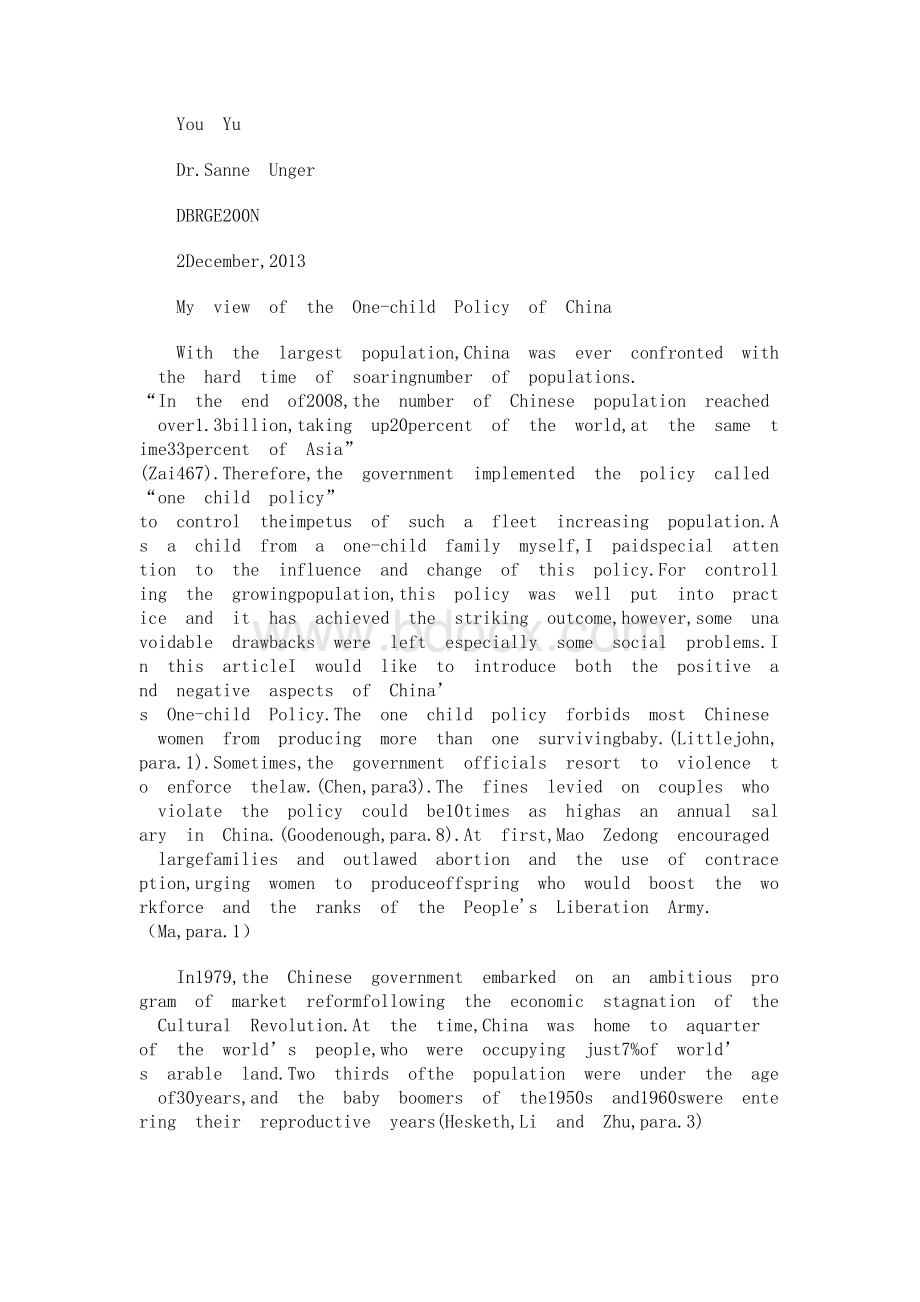research essay.docx
《research essay.docx》由会员分享,可在线阅读,更多相关《research essay.docx(6页珍藏版)》请在冰豆网上搜索。

You Yu
Dr.Sanne Unger
DBRGE200N
2December,2013
My view of the One-child Policy of China
With the largest population,China was ever confronted with the hard time of soaringnumber of populations.“In the end of2008,the number of Chinese population reached over1.3billion,taking up20percent of the world,at the same time33percent of Asia”(Zai467).Therefore,the government implemented the policy called“one child policy”to control theimpetus of such a fleet increasing population.As a child from a one-child family myself,I paidspecial attention to the influence and change of this policy.For controlling the growingpopulation,this policy was well put into practice and it has achieved the striking outcome,however,some unavoidable drawbacks were left especially some social problems.In this articleI would like to introduce both the positive and negative aspects of China’s One-child Policy.The one child policy forbids most Chinese women from producing more than one survivingbaby.(Littlejohn,para.1).Sometimes,the government officials resort to violence to enforce thelaw.(Chen,para3).The fines levied on couples who violate the policy could be10times as highas an annual salary in China.(Goodenough,para.8).At first,Mao Zedong encouraged largefamilies and outlawed abortion and the use of contraception,urging women to produceoffspring who would boost the workforce and the ranks of the People's Liberation Army.(Ma,para.1)
In1979,the Chinese government embarked on an ambitious program of market reformfollowing the economic stagnation of the Cultural Revolution.At the time,China was home to aquarter of the world’s people,who were occupying just7%of world’s arable land.Two thirds ofthe population were under the age of30years,and the baby boomers of the1950s and1960swere entering their reproductive years(Hesketh,Li and Zhu,para.3)
The government saw strict population containment as essential to economic reform and toan improvement in living standards.So the one-child family policy was introduced.(Hesketh,Liand Zhu,para.2)
One-child policy did benefit the whole society when it was put into effect.Chineseauthorities claim that the policy has prevented250to300million births.The total fertility rate,which is defined as the mean number of children born per woman,decreased from2.9in1979to1.7in2004,with a rate of1.3in urban areas and just under2.0in rural areas.(Hesketh,Liand Zhu,para.6) This change has brought China a large number of working population andsmaller number of children which gave the society less burden on the resource,and it helpedChina to rank its development2nd in the world.
As a coin has two sides,this policy also resulted in many problems which drew sharpcritiques from abroad,especially from the western world.However,A“minimum needed”ofone son and daughter implies a cohort total fertility rate (TER) of2.5,even if no couple has nomore than three children.( Merli and Smith,para.2)
The effectiveness of the one-child policy has varied greatly because policy regulations aredifferentially carried out by officials of provinces,municipalities,counties,communes,andminority regions.The state policy has had greater acceptance in urban areas but is far lessrigidly enforced by local officials in rural areas and for certain national minorities,which canhave a second child if the first is female.(Chow and Zhao,para.1) This has greatly influencedthe quality of China’s population,for the well-educated couples with good financial condition inurban areas are restricted to have only one child,but poor couples from rural areas are able tohave more children from the policy’s point of view.This lead to a higher proportion of under-educated population and enlarged the rich-poor gap in China.
The effect of the policy on the sex ratio has received much attention.According to thetraditional minds of Chinese society,boys are more"valuable"than girls for boys are deemedbe able to continue the blood of families.The sex ratio at birth,defined as the proportion ofmale live births to female live births,ranges from1.03to1.07in industrialized countries.Sincethe onset of the one-child policy,there has been a steady increase in the reported sex ratio,from1.06in1979,to1.11in1988,to1.17in2001.There are marked and well-documentedlocal differences,with ratios of up to1.3in rural Anhui,Guangdong,and Qinghai provinces.Data from the2001National Family Planning and Reproductive Health Survey,which wascarried out among a nationally representative sample of39,600women of reproductive ageand is the most recent large-scale survey of reproductive health and fertility,show clearly thatthe increased sex ratio is not confined predominantly to rural China,as has been previouslyassumed.There is a marked gradient across birth order:
in rural areas,the sex ratio for the firstbirth is1.05(within normal limits),but it rises steeply with birth order.In urban areas,the sexratio is1.13for the first birth and peaks at1.30for the second birth but decreases for the thirdand